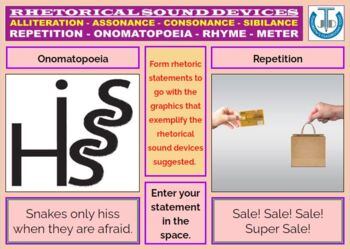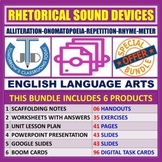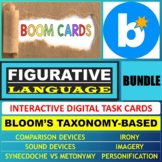SOUND DEVICES - ALLITERATION, ONOMATOPOEIA, REPETITION, RHYME, METER: BOOM CARDS
JOHN DSOUZA
1.1k Followers
Grade Levels
2nd - 10th
Resource Type
Standards
CCSSRL.2.4
CCSSRL.7.4
CCSSL.3.5a
CCSSL.7.5a
CCSSL.8.5
Formats Included
- PDF
- Internet Activities
Pages
96 pages
JOHN DSOUZA
1.1k Followers
Compatible with Digital Devices
The Teacher-Author has indicated that this resource can be used for device-based learning.
Also included in
- These bundled resources are perfect for teaching Rhetorical Sound Devices - Alliteration, Assonance, Consonance, Sibilance, Onomatopoeia, Repetition, Rhyme and Meter. These no prep activities would be great for English lessons or English centers. Your students will love these ELA Boom Cards, GooglePrice $17.50Original Price $25.00Save $7.50
- This bundle of 10 products (Boom Cards) is perfect for teaching Figures of Speech - Simile, Metaphor, Hyperbole, Analogy, Personification, Sensory Imagery, Irony, Synecdoche, Metonymy, Alliteration, Onomatopoeia, Repetition, Rhyme, Oxymoron and Idioms. These no prep activities would be great for ELAPrice $38.70Original Price $43.00Save $4.30
Description
These Boom Cards are perfect for teaching Rhetorical Sound Devices – Alliteration, Assonance, Consonance, Sibilance, Onomatopoeia, Repetition, Rhyme and Meter. These no prep activities would be great for ELA lessons or ELA centers. Your students will love these self-grading exercises that are gamified for student engagement.
After attempting these New Bloom’s Taxonomy based Boom Cards students will be able to:
- Match the terms associated with rhetorical sound devices with their meanings.
- Identify the words that exemplify the rhetorical sound devices in the text.
- Form rhetoric statements to go with the graphics that exemplify the rhetorical sound devices.
- Interpret the rhetorical sound devices used in the text and explain the author’s purpose in using them.
- Identify the impact of the use of rhetorical sound devices in the given text.
- Analyse the given text to interpret the rhetorical sound devices used in them.
These digital task cards:
- Would be great on a Laptop, Desktop, Chromebook or Tablet;
- Can be used on any other mobile device that can access the internet;
- Can even be used on your Smart Board.
Here are some possible uses for these in your classroom:
- To challenge early finishers
- For effective tutoring
- As ESL stations and sub tubs
- As holiday work and homework
- For small group collaborations
- For an end of unit assessments
- For reinforcement and enrichment
More about Boom Learning:
- To use Boom Cards, you must be connected to the Internet.
- Boom Cards play on modern browsers (Chrome, Safari, Firefox, and Edge).
- Apps are available for Android, iPads, iPhones, and Kindle Fires.
- For security and privacy, adults must have a Boom Learning account to use and assign Boom Cards.
- You will be able to assign the Boom Cards you are buying with "Fast Pins," (play provides instant feedback for self-grading Boom Cards).
- Fast Play is always a free way for students to engage with Boom Cards decks.
- For additional assignment options you'll need a premium account.
- If you are new to Boom Learning, you will be offered a free trial of our premium account.
- Readhere for details: http://bit.ly/BoomTrial.
More related Boom Cards by the same author:
This is what teachers say about these resources:
- NOUN TYPES: 77 BOOM CARDS - Flat Rock School: My students love using Boom. It turns learning into a game. Rating: 5/5 (extremely satisfied).
- IDIOMS: 66 BOOM CARDS" - Christine Devine: This was a fun way for students to practice. Rating: 5/5 (extremely satisfied).
Customer Tips: How to get TPT credit to use for future purchases
- Please go to your My Purchases page (you may need to log in). Beside each purchase, you'll see a Provide Feedback button. Simply click it and you will be taken to a page where you can give a quick rating and leave a short comment for the product.
- Each time you give feedback, TPT gives you feedback credits that you use to lower the cost of your future purchases.
- I value your feedback greatly as it helps me determine which products are most valuable for your classroom so I can create more for you.
- Look for the green star next to my store logo and click it to become a FOLLOWER. You will now receive email updates about this store. Be the first to know about my new discounts, freebies, and product launches.
Find Me Here:
- TPT Store - JOHN DSOUZA
- Pinterest - JOHN DSOUZA
- Facebook - TOMORROW’S CLASSROOM TODAY
- Instagram - JOHN421969
- Twitter - JOHN421969
- Blog - TOMORROW’S LESSONS TODAY
Total Pages
96 pages
Answer Key
Included
Teaching Duration
1 hour
Report this resource to TPT
Reported resources will be reviewed by our team. Report this resource to let us know if this resource violates TPT’s content guidelines.
Standards
to see state-specific standards (only available in the US).
CCSSRL.2.4
Describe how words and phrases (e.g., regular beats, alliteration, rhymes, repeated lines) supply rhythm and meaning in a story, poem, or song.
CCSSRL.7.4
Determine the meaning of words and phrases as they are used in a text, including figurative and connotative meanings; analyze the impact of rhymes and other repetitions of sounds (e.g., alliteration) on a specific verse or stanza of a poem or section of a story or drama.
CCSSL.3.5a
Distinguish the literal and nonliteral meanings of words and phrases in context (e.g., take steps).
CCSSL.7.5a
Interpret figures of speech (e.g., literary, biblical, and mythological allusions) in context.
CCSSL.8.5
Demonstrate understanding of figurative language, word relationships, and nuances in word meanings.







